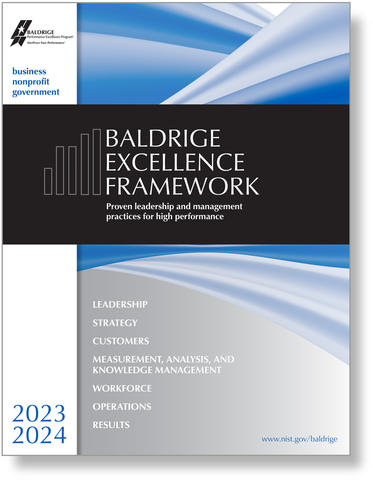Blogrige
The Official Baldrige Blog

Everyone by now has experienced artificial intelligence (AI). It has become part of our lives, from interactive voice assistants (e.g., Alexa, Siri), to Face ID on smart phones and virtual filters on apps, to algorithms on search engines and screening sites that use our behaviors to suggest what we might like or should buy next. I even found an interesting usage of AI as part of a research program in California, where drones search for sharks near the beach and send texts to folks who signed up to be in the know. Drone footage is fed into "a computer vision machine learning model . . . to train it to detect great white sharks near Padaro Beach."
It makes me curious. What are other ways--some being used now and some not yet dreamed about--that AI could support U.S. businesses and other organizations?
Understanding AI
AI, a branch of computer science, is focused on building smart machines that can learn from experience, adjust to new inputs, and perform human-like tasks, according to “8 Examples of Artificial Intelligence in Our Everyday Lives” by Sumbo Bello in the online magazine Edgy. With increases in data volume and advances in algorithms, U.S. organizations across industries have found uses for AI that include complex tasks such as a robot using an algorithm to navigate a space, to targeted identification of customers for a product or service based on that customer’s search history, and data-based predictions about changing market conditions.
The Baldrige Program’s parent organization, the National Institute of Standards and Technology (NIST), recently launched a new testing, evaluation, validation, and verification program intended to help improve the understanding of AI’s capabilities and impacts. Assessing Risks and Impacts of AI (ARIA) aims to help organizations and individuals determine whether a given AI technology will be valid, reliable, safe, secure, private, and fair once deployed.
ARIA joins NIST's other AI-related programs. In collaboration with the private and public sectors, in 2023, NIST released an AI framework to better manage risks to individuals, organizations, and society. The NIST AI Risk Management Framework (AI RMF) is intended for voluntary use and to improve the ability to incorporate trustworthiness considerations into the design, development, use, and evaluation of AI products, services, and systems. NIST recently published a profile of the AI RMF specifically for generative AI systems that will help businesses identify and manage the risks of using generative AI.
To drive global development and implementation of AI-related consensus standards, NIST released A Plan for Global Engagement on AI Standards. The NIST U.S. AI Safety Institute was recently formed to advance the science of AI safety and the implementation and adoption of that science. NIST is also working on a publication for promoting transparency in digital content, which AI systems can alter. NIST recently released a software package designed to measure how adversarial attacks can degrade the performance of an AI system.
AI in the Baldrige Framework
As the Baldrige Program is working on the latest revision (for 2025–2026) of the Baldrige Excellence Framework®, ensuring that AI is appropriately referenced represented some of the most common feedback received from the community, literature, and academics.
Input that the Baldrige Program has received for this revision process has included incorporating AI in the Baldrige definition of innovation; calling it out as a consideration in how an organization engages with customers; and incorporating guidelines for ethical AI that would include responsible and transparent use.
In the Baldrige framework, references to AI are also included in the following areas:
- 2.1 Strategy Development, especially in terms of technological changes that require responsible development and deployment
- 4.2 Information and Knowledge Management, especially in terms of analyzing data and information
- 6.1 Work Processes, especially in terms of considering new technology and the use of AI, for example, for supply chain optimization, predictive analytics, automation, and decision making. AI appears in discussion for both product, service, and process design and process management and improvement.
How would you incorporate AI in the next revision of the Baldrige Excellence Framework?
Notes:
- Check out the Baldrige Foundation’s webinar series; a recent webinar focuses on integrating business architecture, AI, and process management.
- Similarly, the Alliance for Performance Excellence, the network of Baldrige-based state and sector programs, also hosts webinars. A recent one was on "Improving Performance with Generative Artificial Intelligence (AI)."

Baldrige Excellence Framework®
The Baldrige Excellence Framework® has empowered organizations to accomplish their missions, improve results, and become more competitive. It includes the Criteria for Performance Excellence®, core values and concepts, and guidelines for evaluating your processes and results.
Purchase your copy today!
Available versions: Business/Nonprofit, Education, and Health Care





